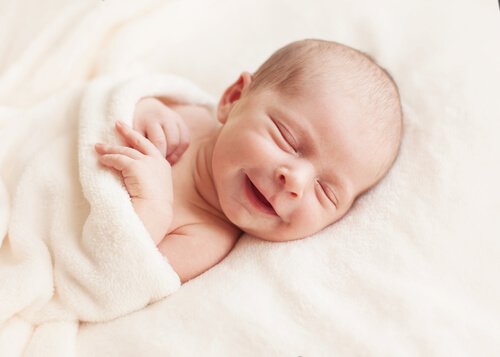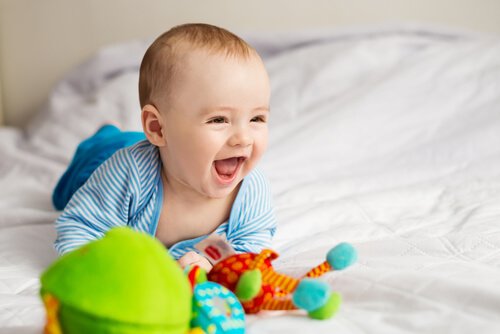What's a Baby's Smile Telling Us?

Most gestures or sounds a newborn baby makes are, in general, adorable. But there’s one that stands out especially: a baby’s smile. When we see such a small being smile or have a giggling fit, it awakens our innermost feelings and emotions. And it’s highly contagious too!
But what’s a baby trying to tell us when they smile? Strangely enough, depending on their age and the situation it occurs in, they may be trying to convey completely different things. It’s something similar to when they cry. As they still can’t use words, they use it as a way of communicating their intentions and needs.
Sometimes they cry to ask for food. Other times because of gases or colic. Or maybe because they need a nappy change or to sleep. That’s why, just as it’s good to know why they’re crying, it’s also good to know what a baby’s smile means.
In the first weeks, a baby’s smile is a reflex
According to numerous studies, during the first weeks of life, the baby’s smile is a reflex. It arises in an innate, involuntary, and automatic way because it’s something that is predetermined in us. The muscle responsible for this gesture is the risorius muscle, which is only present in human beings.
This means that the little one smiles without there necessarily being anything that’s making them laugh. It’s enough for them to simply hear a pleasant sound or see their mother’s face. In many cases, a loving look alone is enough to make them smile.
But as the child matures, it becomes a response to a specific stimulus. There needs to be something specific to trigger it and is a way of expressing an infinite number of emotional nuances. Let’s see what a baby’s smile means as the months go by.

At two months old, a baby’s smile expresses well-being
Two or three months after their birth, a baby’s smile starts to be an expression of their well-being. They smile when they feel satisfied and only when all their basic needs have been met. It’s the purest sign of harmony and happiness. So, if your little one smiles, you can be assured that it’s a sign that everything seems to be going well.
In addition to this, it’s a flexible response, because they can show it in a variety of circumstances. One example of this is after breastfeeding when they realize they’re no longer hungry. Another is after a nice warm bath, as they feel clean and smell good. They can also smile when they wake up in the morning after a good night’s sleep or when their parents pick them up to play with them.
From the fourth month on: The conscious smile
After the 100th day of their life, and up until about they’re sixth months old, the so-called “conscious smile” originates, and it’s selective and preemptive. It’s now a response to an external stimulus that generates pleasure or recognition. It’s a sign that they’re getting used to a daily care routine.
This smile can be caused by their mother’s voice, a song, or by someone who approaches them and smiles at them. It should be noted that at this age the baby already knows how to distinguish between a familiar face and that of a stranger. Because of this, they’re not so friendly with strangers and reserve their smiles only for family members.
Let’s suppose the baby likes something and smiles. At that moment, if the adult smiles back, then they will too. Thus, little by little, that gesture will become a wonderful source of joy.
The first action that usually makes a baby laugh is when someone blows raspberries on their body. They will also laugh when an adult does funny faces or plays “peek-a-boo” with them, hiding behind their hands and then quickly removing them.
But at the same time, as they start to smile consciously, the opposite also happens at 4 months of age. It’s at this time that the child will learn to express themselves by crying in order to express their discomfort.
At six months of age, a whole variety of smiles
Once the first six months have passed, babies can now give different types of smiles, depending on what they want to show: joy, fun, approval, etc. As they grow, their perceptions and sensations become more precise. This variety in a baby’s smile evidences the wealth of emotions the baby is acquiring. Thanks to this evolution in their emotions, those contagious giggle fits we love so much start to appear.
Little by little, they start to learn how to make others laugh, through their attempts at words, babblings, or their gestures and body language. By doing this, they reinforce their social skills and begin to want to be in the middle of everything and to be part of all kinds of games.

From 9 months to a year: The baby is fully conscious of their smile
At 12 months of age, the baby’s smile is enriched to such an extent that they’ll already be using it voluntarily in response to predetermined stimuli. It’s a completely social smile, which they use to show that something has made them happy, made them laugh, or has surprised them. At this point, they also know when not to use it, if they feel fear, pain, or anger, for example.
It’s important that, when your baby smiles, the adult responds in a pleasant and friendly way. They can respond with another smile, a cuddle, a hug, or a game. This is the best way of forming a loving bond and attachment with the baby. It’s also a way of teaching the child that the person in front of them is unique and different and loves them dearly.
Most gestures or sounds a newborn baby makes are, in general, adorable. But there’s one that stands out especially: a baby’s smile. When we see such a small being smile or have a giggling fit, it awakens our innermost feelings and emotions. And it’s highly contagious too!
But what’s a baby trying to tell us when they smile? Strangely enough, depending on their age and the situation it occurs in, they may be trying to convey completely different things. It’s something similar to when they cry. As they still can’t use words, they use it as a way of communicating their intentions and needs.
Sometimes they cry to ask for food. Other times because of gases or colic. Or maybe because they need a nappy change or to sleep. That’s why, just as it’s good to know why they’re crying, it’s also good to know what a baby’s smile means.
In the first weeks, a baby’s smile is a reflex
According to numerous studies, during the first weeks of life, the baby’s smile is a reflex. It arises in an innate, involuntary, and automatic way because it’s something that is predetermined in us. The muscle responsible for this gesture is the risorius muscle, which is only present in human beings.
This means that the little one smiles without there necessarily being anything that’s making them laugh. It’s enough for them to simply hear a pleasant sound or see their mother’s face. In many cases, a loving look alone is enough to make them smile.
But as the child matures, it becomes a response to a specific stimulus. There needs to be something specific to trigger it and is a way of expressing an infinite number of emotional nuances. Let’s see what a baby’s smile means as the months go by.

At two months old, a baby’s smile expresses well-being
Two or three months after their birth, a baby’s smile starts to be an expression of their well-being. They smile when they feel satisfied and only when all their basic needs have been met. It’s the purest sign of harmony and happiness. So, if your little one smiles, you can be assured that it’s a sign that everything seems to be going well.
In addition to this, it’s a flexible response, because they can show it in a variety of circumstances. One example of this is after breastfeeding when they realize they’re no longer hungry. Another is after a nice warm bath, as they feel clean and smell good. They can also smile when they wake up in the morning after a good night’s sleep or when their parents pick them up to play with them.
From the fourth month on: The conscious smile
After the 100th day of their life, and up until about they’re sixth months old, the so-called “conscious smile” originates, and it’s selective and preemptive. It’s now a response to an external stimulus that generates pleasure or recognition. It’s a sign that they’re getting used to a daily care routine.
This smile can be caused by their mother’s voice, a song, or by someone who approaches them and smiles at them. It should be noted that at this age the baby already knows how to distinguish between a familiar face and that of a stranger. Because of this, they’re not so friendly with strangers and reserve their smiles only for family members.
Let’s suppose the baby likes something and smiles. At that moment, if the adult smiles back, then they will too. Thus, little by little, that gesture will become a wonderful source of joy.
The first action that usually makes a baby laugh is when someone blows raspberries on their body. They will also laugh when an adult does funny faces or plays “peek-a-boo” with them, hiding behind their hands and then quickly removing them.
But at the same time, as they start to smile consciously, the opposite also happens at 4 months of age. It’s at this time that the child will learn to express themselves by crying in order to express their discomfort.
At six months of age, a whole variety of smiles
Once the first six months have passed, babies can now give different types of smiles, depending on what they want to show: joy, fun, approval, etc. As they grow, their perceptions and sensations become more precise. This variety in a baby’s smile evidences the wealth of emotions the baby is acquiring. Thanks to this evolution in their emotions, those contagious giggle fits we love so much start to appear.
Little by little, they start to learn how to make others laugh, through their attempts at words, babblings, or their gestures and body language. By doing this, they reinforce their social skills and begin to want to be in the middle of everything and to be part of all kinds of games.

From 9 months to a year: The baby is fully conscious of their smile
At 12 months of age, the baby’s smile is enriched to such an extent that they’ll already be using it voluntarily in response to predetermined stimuli. It’s a completely social smile, which they use to show that something has made them happy, made them laugh, or has surprised them. At this point, they also know when not to use it, if they feel fear, pain, or anger, for example.
It’s important that, when your baby smiles, the adult responds in a pleasant and friendly way. They can respond with another smile, a cuddle, a hug, or a game. This is the best way of forming a loving bond and attachment with the baby. It’s also a way of teaching the child that the person in front of them is unique and different and loves them dearly.
This text is provided for informational purposes only and does not replace consultation with a professional. If in doubt, consult your specialist.







